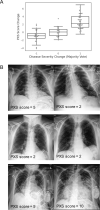Automated Assessment and Tracking of COVID-19 Pulmonary Disease Severity on Chest Radiographs using Convolutional Siamese Neural Networks
- PMID: 33928256
- PMCID: PMC7392327
- DOI: 10.1148/ryai.2020200079
Automated Assessment and Tracking of COVID-19 Pulmonary Disease Severity on Chest Radiographs using Convolutional Siamese Neural Networks
Abstract
Purpose: To develop an automated measure of COVID-19 pulmonary disease severity on chest radiographs (CXRs), for longitudinal disease tracking and outcome prediction.
Materials and methods: A convolutional Siamese neural network-based algorithm was trained to output a measure of pulmonary disease severity on CXRs (pulmonary x-ray severity (PXS) score), using weakly-supervised pretraining on ∼160,000 anterior-posterior images from CheXpert and transfer learning on 314 frontal CXRs from COVID-19 patients. The algorithm was evaluated on internal and external test sets from different hospitals (154 and 113 CXRs respectively). PXS scores were correlated with radiographic severity scores independently assigned by two thoracic radiologists and one in-training radiologist (Pearson r). For 92 internal test set patients with follow-up CXRs, PXS score change was compared to radiologist assessments of change (Spearman ρ). The association between PXS score and subsequent intubation or death was assessed. Bootstrap 95% confidence intervals (CI) were calculated.
Results: PXS scores correlated with radiographic pulmonary disease severity scores assigned to CXRs in the internal and external test sets (r=0.86 (95%CI 0.80-0.90) and r=0.86 (95%CI 0.79-0.90) respectively). The direction of change in PXS score in follow-up CXRs agreed with radiologist assessment (ρ=0.74 (95%CI 0.63-0.81)). In patients not intubated on the admission CXR, the PXS score predicted subsequent intubation or death within three days of hospital admission (area under the receiver operating characteristic curve=0.80 (95%CI 0.75-0.85)).
Conclusion: A Siamese neural network-based severity score automatically measures radiographic COVID-19 pulmonary disease severity, which can be used to track disease change and predict subsequent intubation or death.
2020 by the Radiological Society of North America, Inc.
Figures




Update of
-
Automated assessment of COVID-19 pulmonary disease severity on chest radiographs using convolutional Siamese neural networks.medRxiv [Preprint]. 2020 May 26:2020.05.20.20108159. doi: 10.1101/2020.05.20.20108159. medRxiv. 2020. Update in: Radiol Artif Intell. 2020 Jul 22;2(4):e200079. doi: 10.1148/ryai.2020200079. PMID: 32511570 Free PMC article. Updated. Preprint.
References
-
- ACR Recommendations for the use of Chest Radiography and Computed Tomography (CT) for Suspected COVID-19 Infection | American College of Radiology. https://www.acr.org/Advocacy-and-Economics/ACR-Position-Statements/Recom.... Accessed March 27, 2020.
-
- Albaum MN, Hill LC, Murphy M, et al. Interobserver reliability of the chest radiograph in community-acquired pneumonia. Chest. 1996;110(2):343–350. - PubMed
-
- Loeb MB, Carusone SBC, Marrie TJ, et al. Interobserver Reliability of Radiologists’ Interpretations of Mobile Chest Radiographs for Nursing Home-Acquired Pneumonia. J Am Med Dir Assoc. 2006;7(7):416–419. - PubMed
Grants and funding
LinkOut - more resources
Full Text Sources
Other Literature Sources

